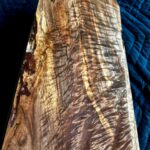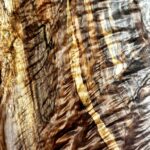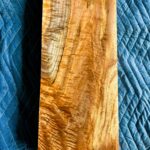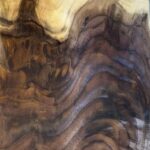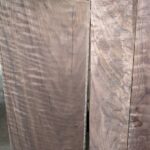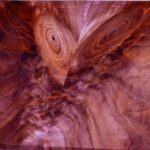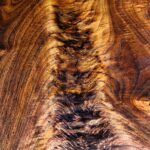(Hint: Like Bob Ross painted it himself — with extra happy little swirls)
Would you rather stare at a slice of unbuttered wheat toast… or a gooey, glistening cinnamon roll? Well, okay, enough said — that’s the end of the blog… just kidding.

All joking aside, that’s exactly the difference between plain wood and figured wood. Have you ever seen a piece of wood that looks like it’s practically moving under the light? Like it’s got depth, dimension, and soul? That, my friend, is what we call figured wood — and once you see it, regular boards just don’t hit the same anymore.
Here at Majesty Woodworks, I work with figured wood whenever I can — not because it’s trendy, but because it’s absolutely mesmerizing. And if you’re investing in custom hardwood furniture, figured wood might just be the thing that turns “nice” into “jaw-dropping.”
What Does “Figured Wood” Actually Mean?
Imagine nature just showing off a little. Figured wood isn’t a species — it’s a pattern. These eye-catching swirls, waves, ripples, and curls happen when the grain in the tree grows in unpredictable ways. Think of it as Mother Nature getting fancy with her brushstrokes.
There are a bunch of types of figure: curly, quilted, birdseye, spalted, flamed — each with its own personality. For example:
Curly maple looks like soft ripples in the ocean, and often has a high-definition look
Quilted mahogany (or any quilted wood) has a puffed, marshmallow, almost 3D effect
- Spalted maple looks like maple grabbed a fine-tip marker — dark lines and jagged shapes that feel almost drawn by hand.
- Mapa Burl (or any burl for that matter) is chaotic and layered — kind of a cross between Birdseye and Quilted
- Birdseye maple is speckled like regular maple got the chicken pox — but in a good way
- Crotch Walnut has swirls or quilts that catch the light and add depth
They’re all rare. Every piece is stunning. And they’re all a pain to mill without tearing out the grain — but that’s half the fun.

Why Should You Care About Figured Wood?
Simple: it makes your furniture unforgettable. When I build something with figured wood, it doesn’t just look “high-end” — it looks alive. And when the light hits it just right? Game over.
Using figured wood in your custom piece turns it into a conversation starter — a statement piece. It’s not just a coffee table anymore — it’s the first thing people notice when they walk into your space. Like a piece of art you can actually use every day. Just about any piece of furniture with figured wood incorporated screams classy. It’s stylish, elegant, and refined. Plus, it says something special about the person who chose it — a love for craftsmanship and timeless design.
In fact, I’ve had guests stop and say, “I can’t believe this is real wood — it looks too perfect to be natural!” That kind of genuine awe happens every time figured wood is involved.
Plus, no two pieces are ever the same. Even if I wanted to, I couldn’t recreate the same pattern twice. It’s a one-of-a-kind look, every time — and isn’t that the whole point of going custom? Even “book-matching” won’t give an identical clone. The second piece will still be off by fractions of an inch. It’s important to add that even the SAME piece of wood might look totally different, front and back.


How I Work with Figured Wood at Majesty Woodworks
Now, working with figured wood isn’t just a matter of tossing it through the planer and hoping for the best. In reality, this stuff needs a gentle touch. That’s why I use sharp hand tools (planes, chisels, card-scrapers), slow feed rates, and a whole lot of patience. Why? Because figured wood has a mind of its own — one wrong move, and that gorgeous grain can tear out like your wife’s pantyhose snagging on the peeling edge of a cheap, plastic veneer desk.
The challenge with figured wood is that its patterns are unpredictable — and that’s exactly what makes it beautiful. The grain often twists, interlocks, or changes direction over and over again, creating all that stunning movement and depth. But it also means I have to be extra careful with every cut. Even the slightest change in tool angle can disrupt the grain. So, precision is key. It’s not a material you rush through. Instead, it’s a slow, deliberate process that rewards attention to detail… and patience. Lots and lots of patience.

How I Work with Figured Wood at Majesty Woodworks
If you’re within earshot while I’m finessing a tricky section, you’ll probably hear a few creative expletives — all part of the process. And trust me, the colorful commentary has only gotten more… imaginative over the years.
Once the shaping and finessing is done, the finishing is where figured wood really comes to life. A proper hardwax oil, shellac, or perfectly smooth lacquer finish brings out the depth — almost like the figure is moving under the surface. In fact, it can feel like it’s glowing from within. Seriously, you could stare at it for hours. (Ask me how I know.) Sure, you can call me obsessed.
You can see figured wood in action in my Curly Maple Drafting Desk. Every angle catches the light differently, like it’s constantly changing. That, right there, is the magic.

Honestly, there’s no picture or video in the world that can do it justice. Instead, you have to stand in front of the piece and move around. The light catches the wood at different angles, making it look like it’s come to life.

Is Figured Wood Right for Your Project?
Not every project needs it — sometimes clean and simple is the way to go. But if you’re after that wow factor… yeah, figured wood delivers. Whether it’s a writing desk, a humidor, or a nightstand that quietly steals the show, I’ll help you decide when and where to use it for maximum impact.
Want a little drama without the sass? Figured wood is your answer. Elegant, unique, and 100% natural. No gimmicks, no shortcuts — just nature doing its thing. Think of it as “armchair candy” — the kind that looks good and feels even better. See what I did there? 😉
Final Thoughts: Let Nature Be Your Co-Designer
Figured wood isn’t something you just pick off a shelf. It’s something you discover — something you stumble upon. And when I come across a board with that perfect curl or shimmer, everything else revolves around it. Whether it’s a dramatic knot filled with epoxy or a board that looks like it’s been lit from within, I design around it. That’s how much it matters.
A few weeks ago, I stopped by my walnut supplier to check out some large slabs he had just pulled from the kiln. He knows how much I love figured wood, so he set aside a random piece of maple he thought I might like — nothing spectacular at first glance, just some nice figuring on each end. The rest of the board didn’t seem like much.
But here’s the thing: I had a vision for how to use the less impressive parts, and once I got it back to the shop and cut off the figured sections… holy crap. After smoothing them out, it turned out to be some of the most stunning figuring I’ve ever seen. I sent him pictures, and even he was blown away.
If you’ve ever browsed CurlyMaple.com, you’ll know how rare it is to find boards with that kind of depth and movement. Hand tool woodworkers like Rob Cosman have made entire careers out of highlighting this kind of material — especially in small, high-end pieces where the grain can really take center stage.
So if you’re dreaming up a custom piece and want something that’s truly unforgettable, let’s talk. I’ll help you choose the wood, the design, and every last detail — and maybe, just maybe, we’ll find a board with a little magic hiding inside.
Thinking figured wood might be your thing?
Let’s turn that hunch into something beautiful. Whether you’ve got a plan or just know you want a piece that turns heads, drop me a line — I’ll help you create something truly one-of-a-kind.
